Abstract
Reduction of cardiac mortality associated with abdominal aortic aneurysm (AAA) repair remains an important goal. Five hundred consecutive urgent or elective operations for infrarenal nonruptured AAA were reviewed. Patients were divided into three groups based on preoperative cardiac status: group I (n = 260, 52%), no clinical or electrocardiographic (ECG) evidence of coronary artery disease (CAD); group II (n = 212, 42.2%), clinical or ECG evidence of CAD considered stable after further evaluation with studies such as dipyridamole-thallium scanning, echocardiography, or coronary arteriography; group III (n = 28, 5.6%), clinical or ECG evidence of CAD considered unstable after further evaluation. Group I had no further cardiac evaluation and groups I and II underwent AAA repair without invasive treatment of CAD. Group III underwent repair of cardiac disease before (n = 21) or coincident with (n = 7) AAA repair. In all instances, perioperative fluid volume management was based on left ventricular performance curves constructed before operation. The 30-day operative mortality rate for AAA repair in all 500 patients was 1.6% (n = 8). There was one (0.4%) cardiac-related operative death in group I, which was significantly less than the five (2.4%) in group II (p less than 0.02). Total mortality for the two groups were also significantly different, with one group I death (0.4%) and seven group II deaths (3.3%), (p less than 0.02). These data support the conclusions that (1) the leading cause of perioperative mortality in AAA repair is myocardial infarction, (2) correction of severe or unstable CAD before or coincident with AAA repair is effective in preventing operative mortality, (3) patients with known CAD should be investigated more thoroughly to identify those likely to develop perioperative myocardial ischemia so that their CAD can be corrected before AAA repair, and (4) patients with no clinical or ECG evidence of CAD rarely die of perioperative myocardial infarction, and thus selective evaluation of CAD based on clinical grounds in AAA patients is justified.
Full text
PDF
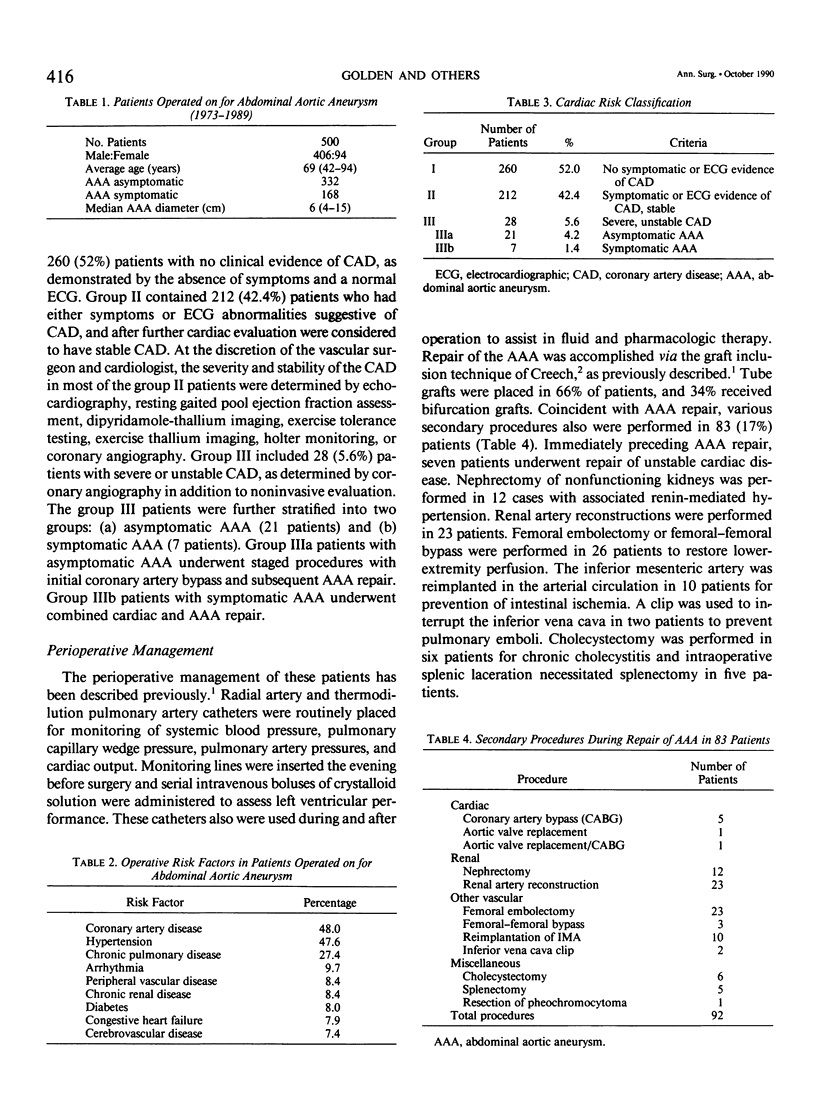
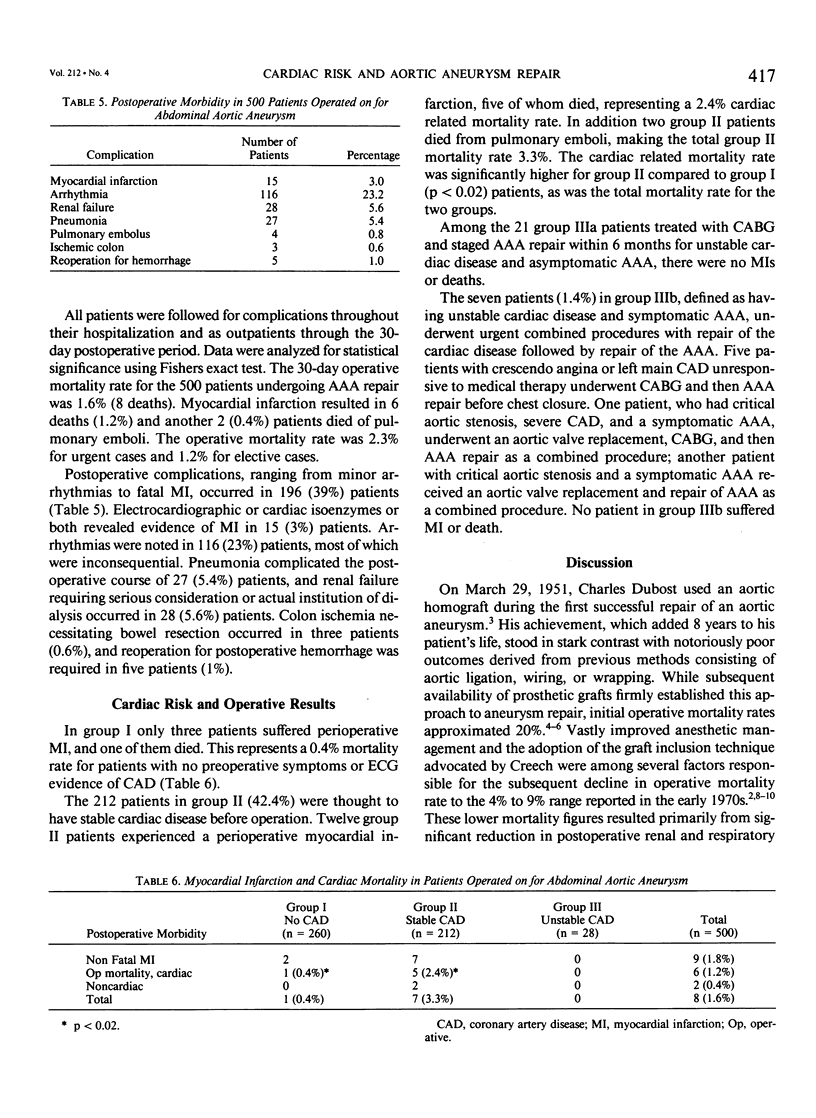
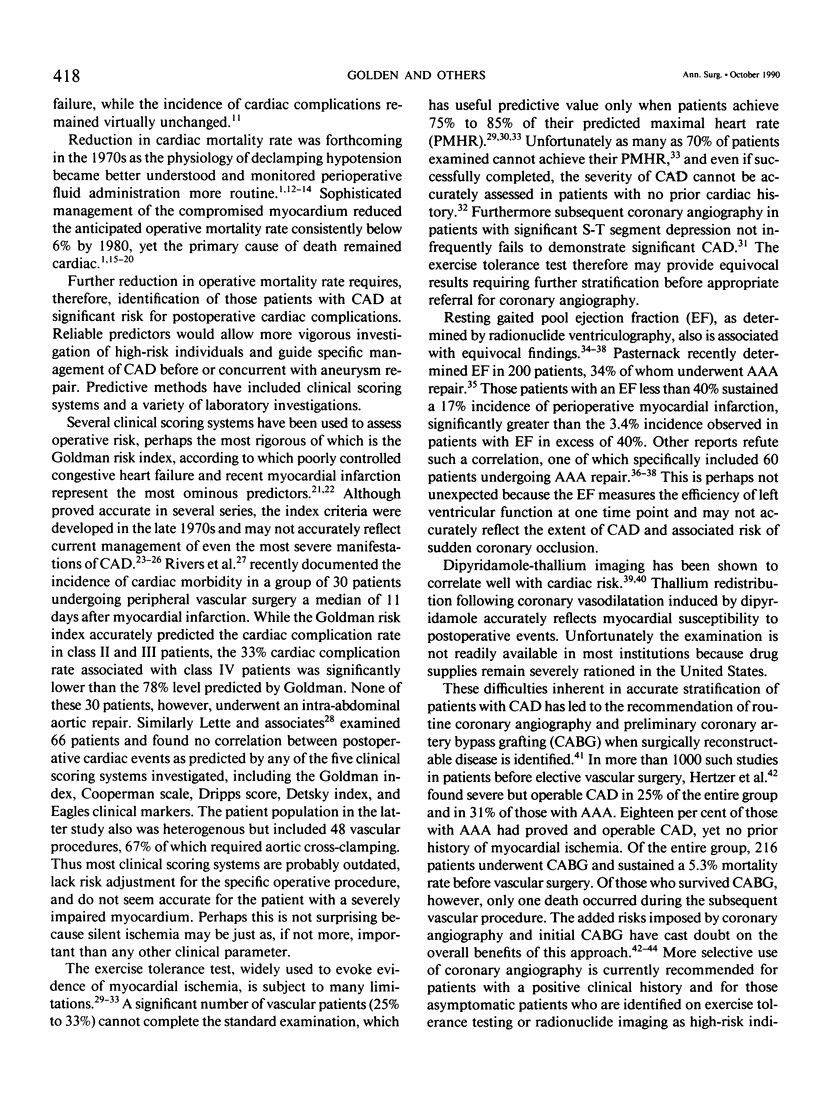
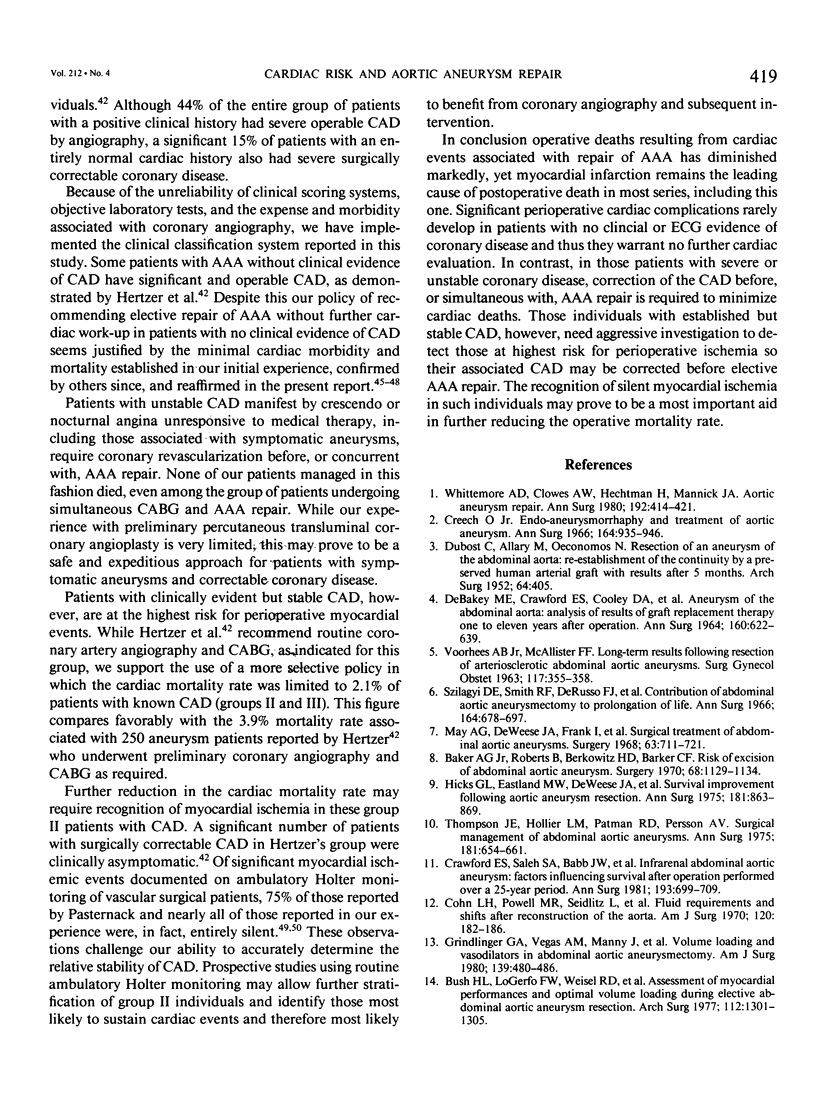
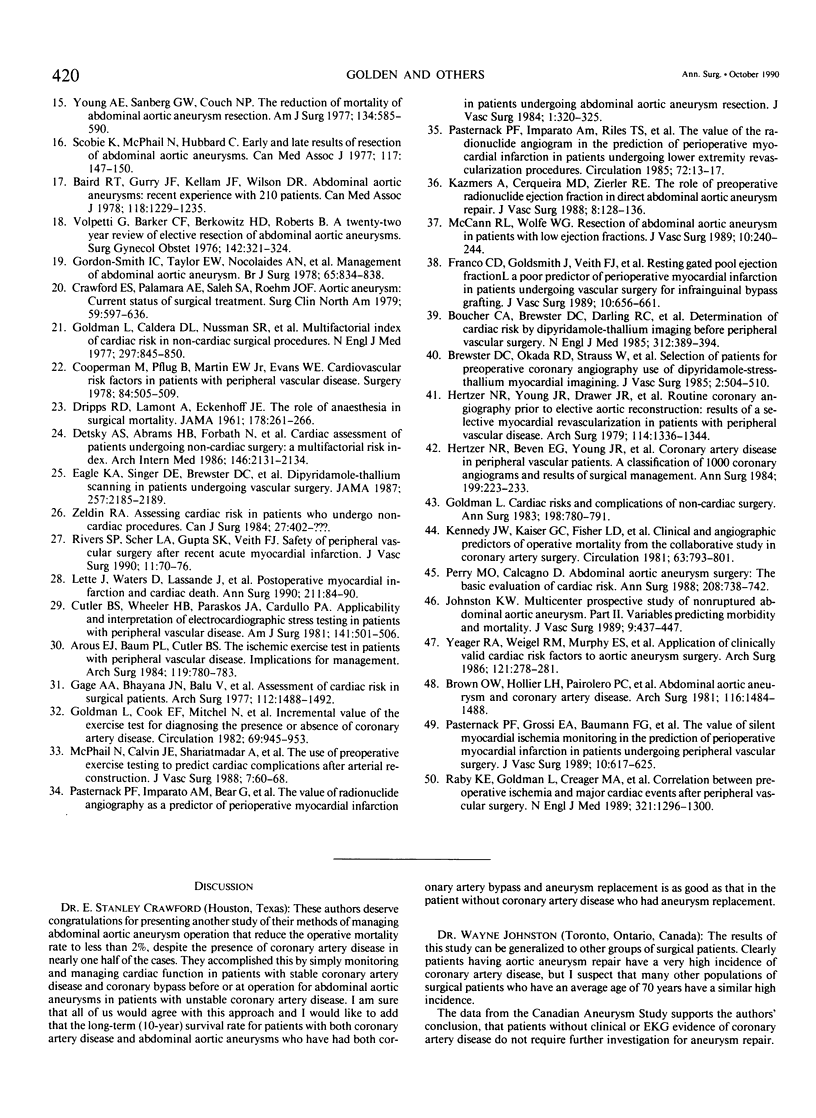
Selected References
These references are in PubMed. This may not be the complete list of references from this article.
- Arous E. J., Baum P. L., Cutler B. S. The ischemic exercise test in patients with peripheral vascular disease. Implications for management. Arch Surg. 1984 Jul;119(7):780–783. doi: 10.1001/archsurg.1984.01390190024005. [DOI] [PubMed] [Google Scholar]
- Baird R. J., Gurry J. F., Kellam J. F., Wilson D. R. Abdominal aortic aneurysms: recent experience with 210 patients. Can Med Assoc J. 1978 May 20;118(10):1229–1235. [PMC free article] [PubMed] [Google Scholar]
- Baker A. G., Jr, Roberts B., Berkowitz H. D., Barker C. F. Risk of excision of abdominal aortic aneurysms. Surgery. 1970 Dec;68(6):1129–1134. [PubMed] [Google Scholar]
- Boucher C. A., Brewster D. C., Darling R. C., Okada R. D., Strauss H. W., Pohost G. M. Determination of cardiac risk by dipyridamole-thallium imaging before peripheral vascular surgery. N Engl J Med. 1985 Feb 14;312(7):389–394. doi: 10.1056/NEJM198502143120701. [DOI] [PubMed] [Google Scholar]
- Brewster D. C., Okada R. D., Strauss H. W., Abbott W. M., Darling R. C., Boucher C. A. Selection of patients for preoperative coronary angiography: use of dipyridamole-stress--thallium myocardial imaging. J Vasc Surg. 1985 May;2(3):504–510. doi: 10.1067/mva.1985.avs0020504. [DOI] [PubMed] [Google Scholar]
- Brown O. W., Hollier L. H., Pairolero P. C., Kazmier F. J., McCready R. A. Abdominal aortic aneurysm and coronary artery disease. Arch Surg. 1981 Nov;116(11):1484–1488. doi: 10.1001/archsurg.1981.01380230098015. [DOI] [PubMed] [Google Scholar]
- Bush H. L., Jr, LoGerfo F. W., Weisel R. D., Mannick J. A., Hechtman H. B. Assessment of myocardial performance and optimal volume loading during elective abdominal aortic aneurysm resection. Arch Surg. 1977 Nov;112(11):1301–1305. doi: 10.1001/archsurg.1977.01370110035003. [DOI] [PubMed] [Google Scholar]
- Cohn L. H., Powell M. R., Seidlitz L., Hamilton W. K., Wylie E. J. Fluid requirements and shifts after reconstruction of the aorta. Am J Surg. 1970 Aug;120(2):182–186. doi: 10.1016/s0002-9610(70)80108-8. [DOI] [PubMed] [Google Scholar]
- Cooperman M., Pflug B., Martin E. W., Jr, Evans W. E. Cardiovascular risk factors in patients with peripheral vascular disease. Surgery. 1978 Oct;84(4):505–509. [PubMed] [Google Scholar]
- Crawford E. S., Palamara A. E., Saleh S. A., Roehm J. O., Jr Aortic aneurysm: current status of surgical treatment. Surg Clin North Am. 1979 Aug;59(4):597–636. doi: 10.1016/s0039-6109(16)41883-9. [DOI] [PubMed] [Google Scholar]
- Crawford E. S., Saleh S. A., Babb J. W., 3rd, Glaeser D. H., Vaccaro P. S., Silvers A. Infrarenal abdominal aortic aneurysm: factors influencing survival after operation performed over a 25-year period. Ann Surg. 1981 Jun;193(6):699–709. doi: 10.1097/00000658-198106000-00005. [DOI] [PMC free article] [PubMed] [Google Scholar]
- Creech O., Jr Endo-aneurysmorrhaphy and treatment of aortic aneurysm. Ann Surg. 1966 Dec;164(6):935–946. doi: 10.1097/00000658-196612000-00001. [DOI] [PMC free article] [PubMed] [Google Scholar]
- Cutler B. S., Wheeler H. B., Paraskos J. A., Cardullo P. A. Applicability and interpretation of electrocardiographic stress testing in patients with peripheral vascular disease. Am J Surg. 1981 Apr;141(4):501–506. doi: 10.1016/0002-9610(81)90148-3. [DOI] [PubMed] [Google Scholar]
- DEBAKEY M. E., CRAWFORD E. S., COOLEY D. A., MORRIS G. C., Jr, ROYSTER T. S., ABBOTT W. P. ANEURYSM OF ABDOMINAL AORTA ANALYSIS OF RESULTS OF GRAFT REPLACEMENT THERAPY ONE TO ELEVEN YEARS AFTER OPERATION. Ann Surg. 1964 Oct;160:622–639. doi: 10.1097/00000658-196410000-00007. [DOI] [PMC free article] [PubMed] [Google Scholar]
- DRIPPS R. D., LAMONT A., ECKENHOFF J. E. The role of anesthesia in surgical mortality. JAMA. 1961 Oct 21;178:261–266. doi: 10.1001/jama.1961.03040420001001. [DOI] [PubMed] [Google Scholar]
- DUBOST C., ALLARY M., OECONOMOS N. Resection of an aneurysm of the abdominal aorta: reestablishment of the continuity by a preserved human arterial graft, with result after five months. AMA Arch Surg. 1952 Mar;64(3):405–408. [PubMed] [Google Scholar]
- Detsky A. S., Abrams H. B., Forbath N., Scott J. G., Hilliard J. R. Cardiac assessment for patients undergoing noncardiac surgery. A multifactorial clinical risk index. Arch Intern Med. 1986 Nov;146(11):2131–2134. [PubMed] [Google Scholar]
- Eagle K. A., Singer D. E., Brewster D. C., Darling R. C., Mulley A. G., Boucher C. A. Dipyridamole-thallium scanning in patients undergoing vascular surgery. Optimizing preoperative evaluation of cardiac risk. JAMA. 1987 Apr 24;257(16):2185–2189. [PubMed] [Google Scholar]
- Franco C. D., Goldsmith J., Veith F. J., Ascer E., Wengerter K. R., Calligaro K. D., Gupta S. K. Resting gated pool ejection fraction: a poor predictor of perioperative myocardial infarction in patients undergoing vascular surgery for infrainguinal bypass grafting. J Vasc Surg. 1989 Dec;10(6):656–661. doi: 10.1067/mva.1989.16173. [DOI] [PubMed] [Google Scholar]
- Gage A. A., Bhayana J. N., Balu V., Hook N. Assessment of cardiac risk in surgical patients. Arch Surg. 1977 Dec;112(12):1488–1492. doi: 10.1001/archsurg.1977.01370120078009. [DOI] [PubMed] [Google Scholar]
- Goldman L., Caldera D. L., Nussbaum S. R., Southwick F. S., Krogstad D., Murray B., Burke D. S., O'Malley T. A., Goroll A. H., Caplan C. H. Multifactorial index of cardiac risk in noncardiac surgical procedures. N Engl J Med. 1977 Oct 20;297(16):845–850. doi: 10.1056/NEJM197710202971601. [DOI] [PubMed] [Google Scholar]
- Goldman L., Cook E. F., Mitchell N., Flatley M., Sherman H., Rosati R., Harrell F., Lee K., Cohn P. F. Incremental value of the exercise test for diagnosing the presence or absence of coronary artery disease. Circulation. 1982 Nov;66(5):945–953. doi: 10.1161/01.cir.66.5.945. [DOI] [PubMed] [Google Scholar]
- Gordon-Smith I. C., Taylor E. W., Nicolaides A. N., Golcman L., Kenyon J. R., Eastcott H. H. Management of abdominal aortic aneurysm. Br J Surg. 1978 Dec;65(12):834–838. doi: 10.1002/bjs.1800651203. [DOI] [PubMed] [Google Scholar]
- Grindlinger G. A., Vegas A. M., Manny J., Bush H. L., Mannick J. A., Hechtman H. B. Volume loading and vasodilators in abdominal aortic aneurysmectomy. Am J Surg. 1980 Apr;139(4):480–486. doi: 10.1016/0002-9610(80)90324-4. [DOI] [PubMed] [Google Scholar]
- Hertzer N. R., Beven E. G., Young J. R., O'Hara P. J., Ruschhaupt W. F., 3rd, Graor R. A., Dewolfe V. G., Maljovec L. C. Coronary artery disease in peripheral vascular patients. A classification of 1000 coronary angiograms and results of surgical management. Ann Surg. 1984 Feb;199(2):223–233. doi: 10.1097/00000658-198402000-00016. [DOI] [PMC free article] [PubMed] [Google Scholar]
- Hertzer N. R., Young J. R., Kramer J. R., Phillips D. F., deWolfe V. G., Ruschhaupt W. F., 3rd, Beven E. G. Routine coronary angiography prior to elective aortic reconstruction: results of selective myocardial revascularization in patients with peripheral vascular disease. Arch Surg. 1979 Nov;114(11):1336–1344. doi: 10.1001/archsurg.1979.01370350138018. [DOI] [PubMed] [Google Scholar]
- Hicks G. L., Eastland M. W., DeWeese J. A., May A. G., Rob C. G. Survival improvement following aortic aneurysm resection. Ann Surg. 1975 Jun;181(6):863–869. doi: 10.1097/00000658-197506000-00019. [DOI] [PMC free article] [PubMed] [Google Scholar]
- Johnston K. W. Multicenter prospective study of nonruptured abdominal aortic aneurysm. Part II. Variables predicting morbidity and mortality. J Vasc Surg. 1989 Mar;9(3):437–447. doi: 10.1067/mva.1989.vs0090437. [DOI] [PubMed] [Google Scholar]
- Kazmers A., Cerqueira M. D., Zierler R. E. The role of preoperative radionuclide ejection fraction in direct abdominal aortic aneurysm repair. J Vasc Surg. 1988 Aug;8(2):128–136. [PubMed] [Google Scholar]
- Kennedy J. W., Kaiser G. C., Fisher L. D., Fritz J. K., Myers W., Mudd J. G., Ryan T. J. Clinical and angiographic predictors of operative mortality from the collaborative study in coronary artery surgery (CASS). Circulation. 1981 Apr;63(4):793–802. doi: 10.1161/01.cir.63.4.793. [DOI] [PubMed] [Google Scholar]
- Lette J., Waters D., Lassonde J., Dubé S., Heyen F., Picard M., Morin M. Postoperative myocardial infarction and cardiac death. Predictive value of dipyridamole-thallium imaging and five clinical scoring systems based on multifactorial analysis. Ann Surg. 1990 Jan;211(1):84–90. doi: 10.1097/00000658-199001000-00015. [DOI] [PMC free article] [PubMed] [Google Scholar]
- May A. G., DeWeese J. A., Frank I., Mahoney E. B., Rob C. G. Surgical treatment of abdominal aortic aneurysms. Surgery. 1968 May;63(5):711–721. [PubMed] [Google Scholar]
- McCann R. L., Wolfe W. G. Resection of abdominal aortic aneurysm in patients with low ejection fractions. J Vasc Surg. 1989 Sep;10(3):240–244. [PubMed] [Google Scholar]
- McPhail N., Calvin J. E., Shariatmadar A., Barber G. G., Scobie T. K. The use of preoperative exercise testing to predict cardiac complications after arterial reconstruction. J Vasc Surg. 1988 Jan;7(1):60–68. [PubMed] [Google Scholar]
- Pasternack P. F., Grossi E. A., Baumann F. G., Riles T. S., Lamparello P. J., Giangola G., Primis L. K., Mintzer R., Imparato A. M. The value of silent myocardial ischemia monitoring in the prediction of perioperative myocardial infarction in patients undergoing peripheral vascular surgery. J Vasc Surg. 1989 Dec;10(6):617–625. doi: 10.1067/mva.1989.15572. [DOI] [PubMed] [Google Scholar]
- Pasternack P. F., Imparato A. M., Bear G., Riles T. S., Baumann F. G., Benjamin D., Sanger J., Kramer E., Wood R. P. The value of radionuclide angiography as a predictor of perioperative myocardial infarction in patients undergoing abdominal aortic aneurysm resection. J Vasc Surg. 1984 Mar;1(2):320–325. doi: 10.1067/mva.1984.avs0010320. [DOI] [PubMed] [Google Scholar]
- Perry M. O., Calcagno D. Abdominal aortic aneurysm surgery: the basic evaluation of cardiac risk. Ann Surg. 1988 Dec;208(6):738–742. doi: 10.1097/00000658-198812000-00011. [DOI] [PMC free article] [PubMed] [Google Scholar]
- Raby K. E., Goldman L., Creager M. A., Cook E. F., Weisberg M. C., Whittemore A. D., Selwyn A. P. Correlation between preoperative ischemia and major cardiac events after peripheral vascular surgery. N Engl J Med. 1989 Nov 9;321(19):1296–1300. doi: 10.1056/NEJM198911093211904. [DOI] [PubMed] [Google Scholar]
- Rivers S. P., Scher L. A., Gupta S. K., Veith F. J. Safety of peripheral vascular surgery after recent acute myocardial infarction. J Vasc Surg. 1990 Jan;11(1):70–76. doi: 10.1067/mva.1990.16624. [DOI] [PubMed] [Google Scholar]
- Scobie K., McPhail N., Hubbard C. Early and late results of resection of abdominal aortic aneurysms. Can Med Assoc J. 1977 Jul 23;117(2):147–150. [PMC free article] [PubMed] [Google Scholar]
- Szilagyi D. E., Smith R. F., DeRusso F. J., Elliott J. P., Sherrin F. W. Contribution of abdominal aortic aneurysmectomy to prolongation of life. Ann Surg. 1966 Oct;164(4):678–699. doi: 10.1097/00000658-196610000-00014. [DOI] [PMC free article] [PubMed] [Google Scholar]
- Thompson J. E., Hollier L. H., Patman R. D., Persson A. V. Surgical management of abdominal aortic aneurysms: factors influencing mortality and morbidity--a 20-year experience. Ann Surg. 1975 May;181(5):654–661. doi: 10.1097/00000658-197505000-00020. [DOI] [PMC free article] [PubMed] [Google Scholar]
- VOORHEES A. B., Jr, MCALLISTER F. F. LONG TERM RESULTS FOLLOWING RESECTION OF ARTERIOSCLEROTIC ABDOMINAL AORTIC ANEURYSMS. Surg Gynecol Obstet. 1963 Sep;117:355–358. [PubMed] [Google Scholar]
- Volpetti G., Barker C. F., Berkowitz H., Roberts B. A twenty-two year review of elective resection of abdominal aortic aneurysms. Surg Gynecol Obstet. 1976 Mar;142(3):321–324. [PubMed] [Google Scholar]
- Whittemore A. D., Clowes A. W., Hechtman H. B., Mannick J. A. Aortic aneurysm repair. Reduced operative mortality associated with maintenance of optimal cardiac performance. Ann Surg. 1980 Sep;192(3):414–421. doi: 10.1097/00000658-198009000-00017. [DOI] [PMC free article] [PubMed] [Google Scholar]
- Yeager R. A., Weigel R. M., Murphy E. S., McConnell D. B., Sasaki T. M., Vetto R. M. Application of clinically valid cardiac risk factors to aortic aneurysm surgery. Arch Surg. 1986 Mar;121(3):278–281. doi: 10.1001/archsurg.1986.01400030032004. [DOI] [PubMed] [Google Scholar]
- Young A. E., Sandberg G. W., Couch N. P. The reduction of mortality of abdominal aortic aneurysm resection. Am J Surg. 1977 Nov;134(5):585–590. doi: 10.1016/0002-9610(77)90440-8. [DOI] [PubMed] [Google Scholar]
- Zeldin R. A. Assessing cardiac risk in patients who undergo noncardiac surgical procedures. Can J Surg. 1984 Jul;27(4):402–404. [PubMed] [Google Scholar]


